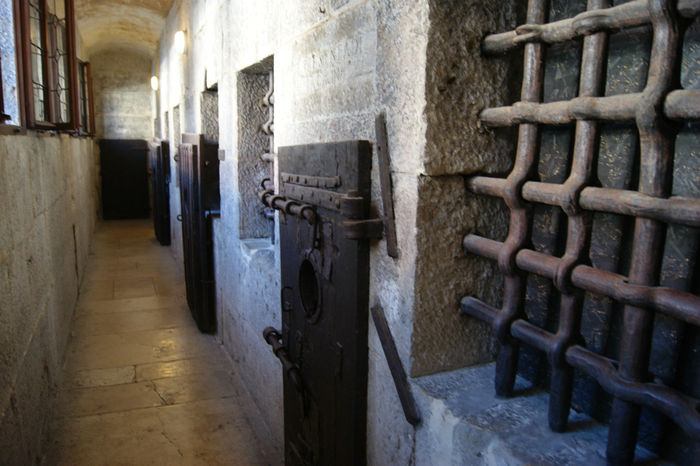Il Piombi
On 26th July, 1755 Giacomo Casanova exchanged the pleasures of the life of a Venetian libertine for that of an inmate in ‘Il Piombi’ (‘The Leads’). His larchwood-lined cell measured eight feet by ten feet and was only five feet in height (Casanova was himself over six feet). The entrance was a lofty three feet in height. For over fifteen months he had remained incarcerated in ‘Il Piombi’, when, during the night of 31st October and 1st November, 1756, along with priest and prison mate Marino Balbi, he made his memorable escape.
Before discussing Il Piombi and Casanova further it is worth pausing to consider European attitudes to crime and punishment as it existed up until that time.
The penal systems of Europe, prior to the mid-eighteenth century, have been described as a theatre of horror. And for good reason. Someone condemned to death, for example, might be burned, drowned, hanged, quartered, flayed, boiled, broken on the wheel, impaled, crushed, decapitated, buried or flung from a cliff. For less serious crimes there was mutilation (such as blinding, castration, the loss of the nose, the ears, a limb or an extremity), flogging, public humiliation, imprisonment and fines. Trials themselves were regularly conducted on the basis of torture to obtain confessions along with ordeals by water, hot iron or combat to obtain proofs of innocence or guilt.
These grisly proceedings, however, were not the product of despotic tyrannies designed to oppress the general population. On the contrary. Crime, especially violent crime, was regarded as a menace by all citizens and there was immense pressure upon authorities to deal with perpetrators harshly. There was a widespread belief that the more severe the punishment the greater the deterrence. Decapitated heads impaled on stakes, corpses hanging from gibbets, criminals being flogged or languishing in the stocks, men and women mutilated and scarred, were everyday reminders to all of the fate that awaited those who failed to keep to the straight and narrow. Authorities that were insufficiently zealous in undertaking their duties would come in for sharp criticism. Moreover, public participation was an intrinsic feature of the judicial process. An execution could be a very large draw, as evidenced in 1757 by that of Robert Damiens, would-be regicide of Louis XV.
Deterrence, however, was not the only driving factor behind these cruelties. Religion and superstition were important motivations, including, paradoxically, concern for the spiritual well-being of the culprit. Physical pain was believed to have purifying properties that would allow a soul to ascend to heaven. So strongly held was this belief, coupled to the belief in an after-life, that those condemned to suffer would often willingly take part in the rituals devised for their torment. The elaborate ceremonial of judicial violence was also intended for the general good as a way of placating an offended God, echoing the fears of more pagan societies such as ancient Greece and Rome that the community as a whole was liable to pay a penalty for the actions of individual members.
Attitudes towards crime and punishment began to shift with the emergence of new Enlightenment thinking. Criticism by scholars such as Bacon and Descartes of Aristotelian Scholasticism, the dominate philosophy of the medieval period, along with the scientific revolution engendered by men such as Galileo and Newton, had begun to undermine beliefs in supernatural causation, most notably witchcraft. By the eighteenth century religious intolerance, the basis for some of the worst examples of judicial violence, was finding itself increasingly under attack by the French philosophes. Voltaire, in particular, from early in the eighteenth century until his death in 1778, campaigned tirelessly for religious toleration and against the abuses of the church (interestingly, before Voltaire, the word ‘intolerant’ connoted a positive quality). In 1764, a key Enlightenment text on systems of justice in Europe, On Crimes and Punishments, was published by Cesare Beccaria (although very much indebted to the thinking of Pietro and Alessandro Verri). Beccaria argued that the criminal justice system should be secular and predictable. It should follow set rules and guiding principles. It should not, as was very much the case at the time, be subject to the arbitrary will of individual rulers, judges or magistrates (or even executioners). Sentences should be proportionate to the offence and torture should play no part in the judicial process. According to Beccaria, punishment should be swift rather than severe as, over time, people become accustomed to the severity of sentencing and it loses its effect as a deterrence. The aim of punishment should not be vengeance but to create a better society. For this reason, he was opposed to capital punishment: it had very little value as a deterrence (he argued that perpetual slavery would have a greater effect) and desensitised society to human suffering.
When we shift our attention to Venice, however, we find that the attitude towards punishment was far more pragmatic than the rest of Europe and characterised by restraint. This was less to do with ideology and more to do with profit and loss. For centuries, the Serenissima had been the world’s pre-eminent trading empire. Its governance, based upon an immensely complex voting system and numerous councils, was designed to prevent tyranny, secular and religious. It was ruled by merchants and the logic of commerce, and one thing every trader knew was that intolerance, with all the social instability and conflict it brought in its wake, was not good for business. As a consequence, by the standards of its times, the republic was forbearing and humane. From the thirteenth century onwards, preferred punishments were fines and imprisonment and the corporal punishment that was used tended to be restricted to beatings and brandings. What was the point of depriving the state of a productive citizen by sentencing them to death or debilitating mutilation? This is not to say that severe and highly ritualised judicial violence would never be employed, especially for serious crimes such as treason against the state, but it was unusual. Specific penalties tended to be left to the discretion of individual judges who would be expected to evaluate the individual circumstances of each case and those involved, both victim and perpetrator. For those who were poor, imprisonment was the main alternative with fines (or a combination of fine and incarceration) for the better off, although from the fourteenth century prison increasingly replaced fines. Unsurprisingly, there was a considerable amount of class favouritism.
‘Il Piombi’ was the special prison of ‘The Council of Ten’, the governing body charged with maintaining the security of the Republic, and therefore the most feared of several prisons located in and alongside Venice’s Doge’s Palace. The present site of the ducal palace stretches back to the twelfth century and Doge Sebastian Ziani (1172-1178) although little of the building erected at that time remains. Construction of the new gothic palace began around 1340. It was, of course, not merely a place of accommodation for the Doge but the city-state’s seat of government. The practical realities of its administrative and judicial functions meant that it was natural for prisoners to be lodged there. Initially these would be holding cells. In the thirteenth and fourteenth centuries, more prison accommodation was built. This was known as ‘Il Pozzi’ (‘The Wells’) due to the dank, dark conditions. In the late sixteenth century, a new prison was built (appropriately named ‘Prigioni Nuove’) which also housed magistrates, ‘I Signori della Notte al Criminal’ (or ‘Signori di Notte’, ‘Lords of the Night’). At the beginning of the seventeenth century (some sources suggest 1600, others 1614) was built ‘Ponte dei Sospiri’ (‘The Bridge of Sighs’, as christened by Lord Byron) crossing the Rio di Palazzo to connect with the ducal palace. Around this same period more cells were built in the ducal palace itself, high up immediately under the lead roof, hence ‘Il Piombi’ or ‘The Leads’.
‘Il Piombi’ was located in the east wing of the palace alongside the inquisitorial offices. Situated where it was, the prison was freezing in winter and roasting in summer. Despite this, compared to the terrible, subterranean ‘Il Pozzi’, the cells were relatively spacious, reflecting the nature of the inmates populating them: political prisoners, those yet to be sentenced, those serving shorter sentences and, generally, prisoners of a higher social status. In his memoirs (Episode 10 – Under the Leads, Chapter XXVI) Casanova describes the moment he was put into his cell (shortly after his gaoler had explained to him the workings of a nearby contraption used to strangle malefactors):
… signing to me to enter, which I did by bending double, he shut me up, and afterwards asked me through the grated hole what I would like to eat.
“I haven’t thought anything about it yet,” I answered. And he went away, locking all the doors carefully behind him.
Stunned with grief, I leant my elbows on the top of the grating. It was crossed by six iron bars an inch thick, which formed sixteen square holes. This opening would have lighted my cell if a square beam supporting the roof which joined the wall below the window had not intercepted what little light came into that horrid garret. After making the tour of my sad abode, my head lowered, as the cell was not more than five and a half feet high, I found by groping along that it formed three-quarters of a square of twelve feet. The fourth quarter was a kind of recess, which would have held a bed; but there was neither bed, nor table, nor chair, nor any furniture whatever, except a bucket—the use of which may be guessed, and a bench fixed in the wall a foot wide and four feet from the ground. On it I placed my cloak, my fine suit, and my hat trimmed with Spanish paint and adorned with a beautiful white feather. The heat was great, and my instinct made me go mechanically to the grating, the only place where I could lean on my elbows. I could not see the window, but I saw the light in the garret, and rats of a fearful size, which walked unconcernedly about it; these horrible creatures coming close under my grating without shewing the slightest fear. At the sight of these I hastened to close up the round hole in the middle of the door with an inside shutter, for a visit from one of the rats would have frozen my blood. I passed eight hours in silence and without stirring, my arms all the time crossed on the top of the grating.
Once safely locked in their cells prisoners were left unsupervised by their gaolers who would only attend to them at day-break. This was to avoid the gaolers being in the way of the Council of Ten, one of the governing bodies of the Serenissima who met in the hall called ‘The Bussola’, which the guards would have to cross every time they went to ‘Il Piombi’. In Casanova’s area of the prison, as an additional punishment, inmates were in cells placed far apart from each other to prevent any communication, although he was eventually moved from his solitary confinement. It was nine months before Casanova was allowed out of his cramped confinement for regular exercise. Prisoners would be expected to pay their gaolers for their food if they wanted to receive anything more than bread and water although they might be awarded small sums of money by the authorities for their upkeep.
Casanova records the perspective of one of his prison guards, a man called Lawrence:
“The prisoners whom I have charge of under the Leads are like yourself, persons of note, and are only guilty of deeds of which the inquisitive must know nothing. If you knew, sir, what sort of people shared your fate, you would be astonished. It’s true that you are called a man of parts; but you will pardon me…. You know that all men of parts are treated well here. You take me, I see. Fifty sous a day, that’s something. They give three livres to a citizen, four to a gentleman, and eight to a foreign count. I ought to know, I think, as everything goes through my hands.”
He then commenced to sing his own praises, which consisted of negative clauses.
“I’m no thief, nor traitor, nor greedy, nor malicious, nor brutal, as all my predecessors were, and when I have drunk a pint over and above I am all the better for it. If my father had sent me to school I should have learnt to read and write, and I might be Messer-Grande to-day, but that’s not my fault. M. Andre Diedo has a high opinion of me. My wife, who cooks for you every day, and is only twenty-four, goes to see him when she will, and he will have her come in without ceremony, even if he be in bed, and that’s more than he’ll do for a senator. I promise you, you will be always having the new-comers in your cell, but never for any length of time, for as soon as the secretary has got what he wants to know from them, he sends them to their place—to the Fours, to some fort, or to the Levant; and if they be foreigners they are sent across the frontier, for our Government does not hold itself master of the subjects of other princes, if they be not in its service. The clemency of the Court is beyond compare; there’s not another in the world that treats its prisoners so well.”
This was the same Lawrence who was later to uncover Casanova’s first escape attempt but who, in the light of a shrewdly judged threat by Casanova to implicate Lawrence himself (ie through incompetence), chose not to disclose this fact to his superiors. Had he done so, Casanova could well have ended up in ‘Il Pozzi’, a nightmarish prospect. In 1788 Casanova published a bestselling account of his escape entitled: ‘The story of my escape from the prisons of the Republic of Venice otherwise known as The Leads’.
Note: references to Casanova’s memoirs relate to the revised unabridged London edition of 1894 (Gutenberg project)
Dave Thompson (2017)


